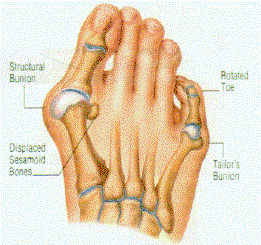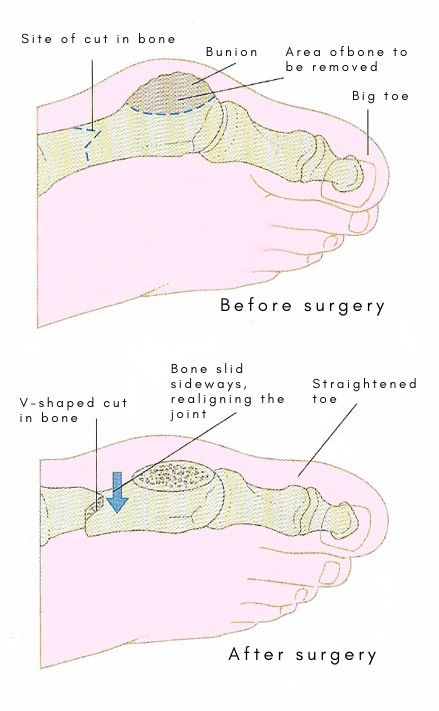bunion

Figure 1. The big toe is turned in, toward the other toes. The bone has become obviously deformed and the soft tissue around it has thickened, forming a painful bunion.

Figure 2. Top: Before surgery. Bottom: After surgery, the protruding part of the bone has been removed and a V-shaped cut made in the lower part of the bone. The big toe is now straight due to realignment of the bone.
A bunion is a deformity of the joint of
the big toe, generally caused by ill-fitting shoes. Pressure on the tissues
at this point creates a bursa which becomes
painfully inflamed.
Bunions occur more commonly in women and can sometimes run in families.
People born with abnormal bones in their feet are more likely to form a
bunion. Wearing narrow-toed, high-heeled shoes may lead to the development
of a bunion. The condition may become painful as extra bone and a fluid-filled
sac grow at the base of the big toe.
Symptoms
Treatment
When a bunion first begins to develop, take good care of your feet and wear wide-toed shoes. This can often solve the problem and prevent the need for any further treatment. It may help to wear felt or foam pads on the foot to protect the bunion, or devices called spacers to separate the first and second toes at night. These are available at drugstores. You can also try cutting a hole in a pair of old, comfortable shoes to wear around the house.
If the bunion gets worse – resulting in severe deformity or pain – surgery to realign the toe and remove the bony bump (bunionectomy) can be effective. There are over 100 different surgical techniques that have been described to treat this condition. A common type of surgical procedure is illustrated in Fig 2. It involves reshaping and realigning the deformed bone at the base of the big toe. The operation is performed under general anesthetic and may require a brief stay in hospital. Normal activity can usually be resumed about six weeks after surgery.
Prognosis
The outlook depends on your age and activities, and the severity of the bunion. Teenagers may have more trouble treating a bunion than adults. Many adults do well by caring for the bunion when it first starts to develop, and wearing different shoes. Surgery reduces the pain in many, but not all, people with bunions.


